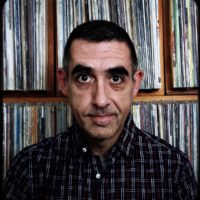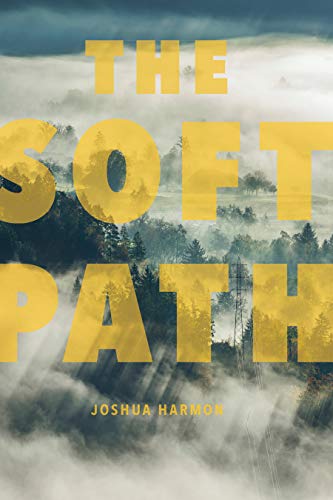Joshua Harmon is unafraid of words. He bends and blends them, severs them then puzzles them back together, creating lines that both philosophize and resonate, lines that both challenge us and that carry us along. His poems are intricate, intelligent, and complex, and not only is he fearless, but he asks the reader for courage too—courage to fully engage with, wrestle down, and absorb these poems.
Harmon is the author of five previous books, including the music-based essay collection The Annotated Mixtape, the short story collection History of Cold Seasons, and the poetry collection Le Spleen de Poughkeepsie. Harmon’s third book of poetry, The Soft Path, is an at times daunting though persistently rewarding collection of sound and landscape, of fragmented language and tenacious poetic cycles, of meaning-making and of diving into our political and environmental quagmires.
Joshua Harmon and I spoke over the course of May and June, tackling the ever-evolving pandemic, the idea of words as a call to arms, the natural world mixing with the technological one, how poetry collections build on one another, and what it means to take the “soft path.”
***
The Rumpus: First things first: how are you holding up during this pandemic? Are you going stir-crazy? Are you writing? If not, how come? And if you are, how’s that going?
Joshua Harmon: I’m dismayed—but not surprised—at how quickly a health crisis became an ideological one. For the past four months, during which time I’ve pretty much only left home to ride my bike or walk the dog, I’ve thought often of Pascal’s famous line. I’ve never had much problem staying alone in my room. I’d love to be out and seeing friends, but I’m not concerned about my comfort—I’m concerned about everyone’s health, the narcissistic criminal who’s utterly bungled the response to the pandemic, his supporters who think it’s a hoax and refuse to wear masks. What more is there to say? Every day our government reaches a new low.
I’m writing, yes, though I’ve found it somewhat hard to concentrate even on days I don’t read the news. I’ve been tinkering with Fantasia 1977, a book project I began in 2011 from a failed essay that would’ve otherwise gone into The Annotated Mixtape. After Mixtape came out in late 2014, I put my energy into The Soft Path. It felt obscene to be writing about cultural iterations of fantasy from the 1970s while confronting the reality that much of the country was fantasizing for the return of a white Christian state, and I stopped for a while. I mean, who cares about The Love Boat or Fantasy Island (two television shows that premiered in 1977) when Nazi sympathizers are marching openly in our cities? Events in my own life ultimately led me back into the material, and I was writing a lot until late January, early February, when it again felt irresponsible if not impossible to immerse myself in San Francisco’s Search & Destroy punk fanzine, or old episodes of Kojak.
Rumpus: Let’s chat about The Soft Path, a discerning and heady set of poetry that swings with language and cuts with significance. To setup the origin of your title and the dichotomy of the book, you use a frontispiece quote from Amory B. Lovins’s prepared testimony to the United States Senate from Dec. 9, 1976, which states in part that “The choice between the soft and the hard paths is urgent.” Can you give us a primer on what exactly the “soft path” means for you, and for this book?
Harmon: I started writing the earliest poems in the book as Deepwater Horizon was spilling oil into the Gulf of Mexico for five months. In the long shadow of the 2008 Recession, I was also in an extended process of—what’s the term? involuntary separation?—from a job I loved, with colleagues who were also among my closest friends. So, I began writing the book as I reluctantly became what the US Census Bureau calls an “extreme commuter.” Previously, I could walk to work; now, I drove two hundred fifty to five hundred miles there and back each week. So, my daily life involved, both literally and figuratively, an equally reluctant investment in the hard path. Driving quickly came to feel a form of slow disintegration—and I had an “easy” commute, in that I didn’t have to deal with traffic, only duration and distance. Some days I spent four hours alone in a car, then arrived home too exhausted to speak.
Beyond that, during the time I wrote the book, carbon dioxide concentrations in the atmosphere exceeded four hundred parts per million, and “superstorms” and “global weirding” became normalized expressions of weather, and I felt an even deeper sense of personal responsibility for those things. So all of that grief and fragmentation and self-disgust went into those poems, which I often composed as voice memos on my phone as I drove. It took me years to finish “Horizontal Dropouts,” the long poem that’s the heart of the book. I guess working from home—assuming it sticks for many people, though I’m not sure it will—is one way we might implement a softer-path approach to living. But in the years I was writing the book it meant a world where the vagaries of capital and networks (financial markets, the internet, the power grid, the interstate highway system, fossil fuel pipelines) didn’t destroy ecosystems and the humans, animals, and plants that inhabit them. I know of a man who lives near me and who sold his car over a decade ago, downsized his possessions and home, and only rides a bicycle to accomplish all of his errands. That’s a form of soft-path living I often wish I were courageous enough to undertake.
On a more personal level, I was a kid in the 1970s. I waited in lines at gas stations. My father installed a wood stove to heat our home. The magazines I read then—National Geographic World, Ranger Rick—contained articles about wildlife habitats, recycling, underground houses. My father worked as an engineer and was always interested in energy efficiency, and my family spent a lot of time outdoors and cared deeply about conservation, so I’ve been contemplating these issues for most of my life.
Rumpus: How much of The Soft Path is a call to arms? What amount of your words here are intended to evoke change?
Harmon: None of it, really. I side with Oppen in believing that poems aren’t going to effect political change, and that, as he puts it in “The Mind’s Own Place,” “to use verse for this purpose, as everyone perfectly well knows, is merely excruciating.” That isn’t to say that some of my favorite books of poems aren’t founded in political outrage or despair—for example, Inger Christensen’s alphabet—but only that if I wanted to use words to call people to arms (and in any case, I feel strongly that the world needs way fewer arms than it currently possesses), I wouldn’t be writing poems, since poetry seems one of the linguistic forms to which few beyond its practitioners pay much attention. Many, many others have written far more persuasively and urgently about climate change than I have. The Soft Path merely registers one speaker’s melancholy response to this horrible historical moment where we all know (and have known for decades) that the world is being destroyed, but refuse to do anything about it because of our love of cheap goods and conveniences and the persistence of habit and an inability to imagine alternative ways of living.
Rumpus: Many stanzas mix the natural (i.e., snow, landscape) with technology (i.e., numbers, data). What does this mixture do for you as a poet? What is it that excites you about the collision or collusion of those two elements?
Harmon: Technology is our most common landscape, no? The metaphors we’ve used for the internet have posited it as a location—one we’ve surfed, scrolled through, gotten lost in. It’s been a superhighway, a frontier, a marketplace, a cloud. The distinctions “virtual reality” and “IRL” have become useless. Routing apps have rendered an attention to landmarks—to land, period—irrelevant as a means of navigation. Near my home in western Massachusetts there are “discontinued roads”—i.e., old dirt roads that a town decided were no longer worth the cost or effort to maintain, and which have since reverted to rocky trails, sometimes passable, but usually only on foot or by bicycle. Residents often mark these with signs reading “Your GPS is wrong!” so that people following their phones don’t end up with their cars stuck in a stream bed.
My students, in our Zoom meetings this spring, used various backdrops: a painting of a train car’s interior, the conference room from The Office, a sky filled with stars. When they switched to their actual bedrooms or kitchens—or positioned themselves in front of blank white walls, to evade personal statement or identification—was that more or less real than the other backgrounds? In what way is an Instagram shot of a field—even one tagged #nofilter, if anyone still does that—real? I try to spend at least part of every day outside—at least an hour or two walking or riding a bike, or both. It’s a minor antidote to how much time I spend in front of a screen, and it’s where I encounter much of what later ends up in my poems. I don’t think any of this is answering your question, though I may not be able to. I don’t feel “excited” by the collision/collusion of technology and nature—a better verb might be “depressed,” “overwhelmed,” or “terrified.”
Rumpus: You’ve mentioned it a little already, but how does this collection build upon your previous work, and where does it deviate most?
Harmon: My books of poetry all have some overlap—in terms of their composition—with the previous one. That is, I started working on Le Spleen de Poughkeepsie before Scape was entirely done, and some of the earliest material in The Soft Path existed as drafts while I was finishing Le Spleen. All three books are concerned with place, with technology, with the sounds of language. Scape was maybe purest in its approach to the latter, in that some of the poems sacrifice narrative logic in favor of sound logic. Le Spleen de Poughkeepsie—in part because of its basis in Baudelaire’s poems, in part because I was feeling overwhelmed by all the minute particulars of living in that small city as the 2008 Recession unfolded—is perhaps a study of place through those kinds of particulars: rusted rebar poking from crumbled concrete, pickup trucks painted with flames, chimney fires.
I began writing The Soft Path when I knew I’d be leaving Poughkeepsie, but before I’d settled anywhere else, and so in that sense it’s almost a record of placelessness, of being “in between,” as the book has it. It feels to me like a book composed on the move, in fragments (it was), but also a book about how commuting (among many other forces) often keeps us from anything but a superficial relationship with places: here’s the street where I turn left, here’s my exit, here’s that annoying stoplight, here’s the easiest gas station to get in and out of, etc., etc. That kind of life is exhausting, and I think this book reflects that. When I showed a friend a draft of the manuscript, he—confronted with the forty-five unbroken pages of “Horizontal Dropouts”—asked me, “Do you even like your readers?” Of course I do. But I wanted the form of this book to be exhausting itself, since it describes so much that’s been exhausted in our world: time, place, privacy, the non-performative self.
***
Photograph of Joshua Harmon courtesy of Joshua Harmon.





